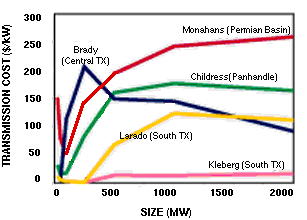|
Texas clearly possesses abundant renewable energy resources. The
presence of a good resource area alone, however, does not guarantee
that it will be exploited to provide useful energy services. Issues
such as potential environmental and social impacts, public
acceptance, and a host of technical and financial matters will
dictate whether a site is acceptable for development. One significant
technical issue relates to the ability to economically move energy
from a good resource area to a location where it can be used.
Many technologies employing renewable energy sources are well
suited to small-scale, distributed applications located where the
energy service is needed. Examples include daylighting of structures,
properly designed roof overhangs (to reduce cooling requirements),
rooftop solar panels, ranch and farm wind turbines, and space heating
from firewood or geothermal sources.
Distributed generation serving end-use loads incurs neither the
losses associated with the delivery of electricity (losses of about
10%) nor the transportation energy required for the delivery of solid
and gaseous fuels. Additionally, distributed generation frees up
capacity of conventional energy delivering systems, thereby reducing
the need for additional investment in transportation infrastructure.
In a study for the SEDC, several of the state's major electric
utilities evaluated the cost of electric transmission facilities
needed to transport electricity from five renewable energy resource
areas to major population centers such as Dallas, Houston, and San
Antonio. Their results, summarized in Figure 16 below, indicate that
renewable energy installations at different locations in Texas may
incur significantly different transmission costs. For instance,
transmission improvements needed to carry electricity from some areas
of West Texas may add as much as 35% to the total price tag for a
large wind power plant. Yet, if this same wind plant were located
near Kleberg in South Texas, transmission costs would amount to less
than 5% of the total project cost.

FIGURE 16. Electric Transmission Costs.
Summarizes improvements required at five prospective power plant
sites.
A second study that examined the Texas electric grid was performed
by Electric Power Engineers (EPE) in conjunction with this resource
assessment project. Their goal was to evaluate limits of the Texas
transmission network in distributing electric power generated from
renewable resources. Twenty-nine prospective renewable energy
generation sites distributed throughout the state were considered.
Even with no new power lines, the EPE load flow analysis suggests
that many large renewable energy power plants could be added to the
grid (Figure 17). The small numbers in the Panhandle and Trans-Pecos
suggest that new transmission lines will be required to build sizable
power plants in these good resource areas.

FIGURE 17. CapacityLimits.
Each value is an estimate of the maximum generation potential (MW) at
that site assuming no new power lines are built. For reference, in
1993, total installed generation capacity in Texas was 68,163
MW.
In addition to electricity, one of the most promising near-term
market pathways for Texas renewables is in the transportation sector.
A new federal regulation requires that a portion of the oxygenates
used in the making of reformulated gasoline (RFG) be derived from
renewable sources. RFG will be mandated in many cities with air
pollution problems. Much of the nation's capacity for manufacturing
fuel oxygenates is in Texas, and Texas biomass could someday be a
source for the alcohols from which they are derived.
| 


